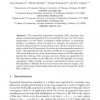Free Online Productivity Tools
i2Speak
i2Symbol
i2OCR
iTex2Img
iWeb2Print
iWeb2Shot
i2Type
iPdf2Split
iPdf2Merge
i2Bopomofo
i2Arabic
i2Style
i2Image
i2PDF
iLatex2Rtf
Sci2ools
ESA
2006
Springer
2006
Springer
Negative Examples for Sequential Importance Sampling of Binary Contingency Tables
The sequential importance sampling (SIS) algorithm has gained considerable popularity for its empirical success. One of its noted applications is to the binary contingency tables problem, an important problem in statistics, where the goal is to estimate the number of 0/1 matrices with prescribed row and column sums. We give a family of examples in which the SIS procedure, if run for any subexponential number of trials, will underestimate the number of tables by an exponential factor. This result holds for any of the usual design choices in the SIS algorithm, namely the ordering of the columns and rows. These are apparently the first theoretical results on the efficiency of the SIS algorithm for binary contingency tables. Finally, we present experimental evidence that the SIS algorithm is efficient for row and column sums that are regular. Our work is a first step in determining rigorously the class of inputs for which SIS is effective.
| Added | 22 Aug 2010 |
| Updated | 22 Aug 2010 |
| Type | Conference |
| Year | 2006 |
| Where | ESA |
| Authors | Ivona Bezáková, Alistair Sinclair, Daniel Stefankovic, Eric Vigoda |
Comments (0)

